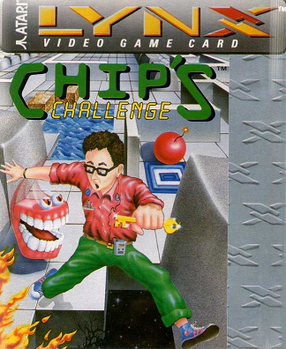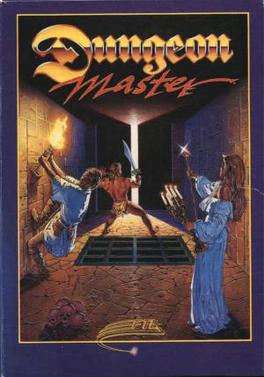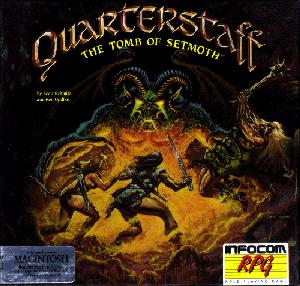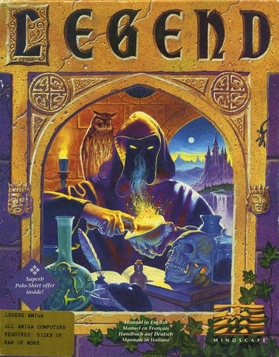
Populous is a video game developed by Bullfrog Productions and published by Electronic Arts, released originally for the Amiga in 1989, and is regarded by many as the first god game. With over four million copies sold, Populous is one of the best-selling PC games of all time.

Mario Is Missing! is a 1993 educational game developed and published by The Software Toolworks for MS-DOS, Nintendo Entertainment System, and Super Nintendo Entertainment System, later released on Macintosh in 1994. The player controls Luigi, who must travel around the world to find and return stolen treasures as part of a quest to find his brother, Mario, who has been captured by Bowser. Mario Is Missing!, part of a series of educational Mario games, was Luigi's second starring role in a video game, following the 1990 Game Watch game Luigi's Hammer Toss and preceding the 2001 GameCube game Luigi's Mansion.

Chip's Challenge is a top-down tile-based puzzle video game originally published in 1989 by Epyx as a launch title for the Atari Lynx. It was later ported to several other systems and was included in the Windows 3.1 bundle Microsoft Entertainment Pack 4 (1992), and the Windows version of the Best of Microsoft Entertainment Pack (1995), where it found a much larger audience.

The Fool's Errand is a 1987 computer game by Cliff Johnson. It is a meta-puzzle game with storytelling, visual puzzles, and a cryptic treasure map. It is the tale of a wandering Fool who seeks his fortune in the Land of Tarot and braves the enchantments of the High Priestess. A sequel titled The Fool and His Money was released October 25, 2012.

Dungeon Master is a role-playing video game featuring a pseudo-3D first-person perspective. It was developed and published by FTL Games for the Atari ST in 1987, almost identical Amiga and PC (DOS) ports following in 1988 and 1992.

Star Wars is a first-person rail shooter designed by Mike Hally and released as an arcade video game in 1983 by Atari, Inc. It uses 3D color vector graphics to simulate the assault on the Death Star from the 1977 film Star Wars. There are three connected gameplay sequences: combat against TIE fighters in space, flying across the surface of the Death Star, and the final trench run. The sequence repeats with added complications and the Death Star regenerating for each. The player's X-Wing fighter has a shield which only protects against damage a certain number of times, then the next hit ends the game. Speech synthesis emulates actors from the film.

Temple of Apshai is a dungeon crawl role-playing video game developed and published by Automated Simulations in 1979. Originating on the TRS-80 and Commodore PET, it was followed by several updated versions for other computers between 1980 and 1986.

Dark Castle is a 1986 platform game for Macintosh that was originally published by Silicon Beach Software. The original game was designed and animated by Mark Pierce and programmed by Jonathan Gay with Real Sound by Eric Zocher. In Dark Castle, a young hero named Duncan tries to make his way to the evil Black Knight, dodging objects as well as solving occasional puzzles.

Moonmist is an interactive fiction computer game written by Stu Galley and Jim Lawrence and published by Infocom in 1986. The game was released simultaneously for the Amiga, Amstrad CPC, Apple II, Atari 8-bit family, Atari ST, Commodore 64, MS-DOS, TRS-80, TI-99/4A, and Macintosh. It is Infocom's twenty-second game. Moonmist was re-released in Infocom's 1995 compilation The Mystery Collection, as well as the 1996 compilation Classic Text Adventure Masterpieces.

The Software Toolworks, Inc., was an American software and video game developer based in Novato, California. The company was founded by Walt Bilofsky in 1980 out of his Sherman Oaks garage, which he converted into an office, to develop software for the Heathkit H89 microcomputer. It quickly expanded into video games, releasing Airport and MyChess in 1980; other notable games include Chessmaster 2000, Mavis Beacon Teaches Typing, and Mario Is Missing!. Toolworks merged with its distributor, Software Country, in 1986 and, after going public in 1988, acquired IntelliCreations, DS Technologies, and Mindscape. By 1994, Toolworks employed 600 people and had a revenue of US$150 million. In May that year, it was acquired by Pearson plc for $462 million, which converted it to bear the Mindscape identity by November.

At The Carnival is a puzzle video game by Cliff Johnson published in 1989 by Miles Computing.

Quarterstaff: The Tomb of Setmoth is an interactive fiction role-playing video game developed by Scott Schmitz and Ken Updike and released by Infocom for Macintosh in 1988. The game features a text parser, graphics, a dynamically updated map, and a graphical interface that incorporates Mac OS hierarchical menus.

Legend, also known as The Four Crystals of Trazere in the United States, is an isometric fantasy role-playing game released in 1992 for the Amiga, Atari ST, and DOS. It was developed by Pete James and Anthony Taglione for the then UK-based Mindscape, and published by The Software Toolworks. In the game, the player controls four adventurers on a quest to save the land of Trazere from an ancient, re-awakening evil. In 1993, Mindscape released a sequel, Worlds of Legend: Son of the Empire. The copyrights for both "Legend" and "Worlds of Legend" are currently owned by Ubisoft, who bought them from Mattel Interactive with the rest of the Mindscape library in 2001.

Ishido: The Way of Stones is a puzzle video game released in 1990 by Accolade and developed by Publishing International. It was designed by Michael Feinberg and programmed by Ian Gilman and Michael Sandige. The game's producer was Brad Fregger, and Brodie Lockard contributed with graphics.

Test Drive is a racing video game developed by Distinctive Software and published by Accolade, released in 1987 for the Amiga, Atari ST, Commodore 64, and DOS, in 1988 for the Apple II, and later ported for the PC-98 in 1989. It is the first game in the Test Drive series.

The Chessmaster 2000 is a computer chess game by The Software Toolworks. It was the first in the Chessmaster series and published in 1986. It was released for Amiga, Apple II, Atari 8-bit family, Atari ST, ZX Spectrum, Commodore 64, Amstrad CPC, MSX, Macintosh, and IBM PC compatibles.

Life & Death II: The Brain is a 1990 video game published by The Software Toolworks.

Balance of the Planet is a simulation video game developed by Chris Crawford. He self-published it in 1990 for Macintosh. It was ported to MS-DOS and PC-98.

Trump Castle is a series of gambling video games published by Capstone Software between 1989 and 1993. The games are named after Trump's Castle hotel-casino in Atlantic City, New Jersey, and were released for Amiga, Atari ST, Commodore 64, Commodore 128, and MS-DOS.
XOR Corporation was a video game developer and publisher based in Minnetonka, Minnesota, founded in 1982 by Glenn Diamond. XOR was active until 1990 and primarily released games for DOS and Macintosh, but also released the DOS business applications Blu Chip, a stock portfolio manager, and Thoth, a database manager, and the C utility C Tools.




















